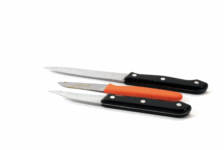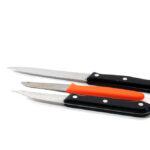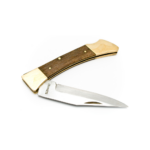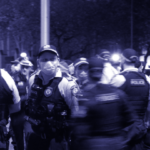NSW Police Force Targets the Possession of Knives in Public Places

The New South Wales Police Force has hailed a recent high-visibility operation to be a great success, removing over 100 weapons from the streets and leading to hundreds arrested and charged with criminal offences.
Operation Foil III ran across the state from Thursday 25 to Saturday 27 September 2025 and involved over 600 officers deployed to crime hot-spots in urban and regional areas of the state, leading to seizure of 127 weapons – including knives, firearms, and ammunition – and 258 detections for drug possession and drug supply. A total of 204 people were charged with 408 offences.
Operation Foil
Operation Foil is a recurring, short-duration, high-visibility policing strategy run by NSW Police that concentrates resources (transport, youth, public safety and local commands) on places and times where knives and other weapons are known to be carried or used.
Typical tactics include:
- Stop-and-searches at transport hubs and high-footfall locations, often using hand-held metal detectors (linked operations like Operation Ares use wand scans);
- Vehicle stops and targeted patrols;
- Collaboration with Youth Command for school visits, welfare checks and diversion;
- Rapid, visible enforcement to deter carrying knives in public.
Operations Foil has been run from 2023 to 2025 with varying reported results.
The two-day deployment in June 2023 reported 294 knives seizures; December 2024 saw about 62 weapons seized; April 2025 about 61 weapons; and September 2025 about 127.
Violent Crime Across Australia
Nationally, knives are the most commonly used weapon in violent crime in Australia and are frequently a weapon in homicide and serious assaults.
Recent national data suggests rising homicide rates in 2023–24 (448 victims recorded in 2024), though overall homicide rates remain low by historical standards. Knives are implicated in a substantial share of those incidents.
At the same time, some state-level research (e.g., BOCSAR in NSW) indicates that recorded violent offences involving knives and firearms have been stable or trending down over the long term — but public concern frequently spikes after several high-profile incidents, such as in Bondi, driving both political and policing responses. That tension — between overall stable/decreasing rates and spikes of serious incidents — helps explain the repeated use of high-visibility operations like Foil.
Put simply, operations like Foil are designed to address the availability and carrying of knives (an upstream risk factor) even when long-term datasets show mixed trends, because individual serious incidents can have an outsized social impact.
Operation Foil and Knife Crime in NSW
The New South Wales Police Force has used Operation Foil repeatedly as a tactical response; the operation’s strength is concentrated, measurable enforcement (seizures, charges, scans), and visible activity intended to deter carrying knives — particularly in transport hubs and known hotspots.
For example, the September 2025 deployment reported the seizure of 127 weapons and the charging of 204 people. Similar prior deployments resulted in large numbers of searches, move-on directions, drug detections, and knife seizures (e.g., 294 knives seized in June 2023, 62 in December 2024, and 61 in April 2025).
NSW analytical bodies (BOCSAR) show that assaults/robberies involving knives are not necessarily rising year-on-year and over decades have been relatively stable or decreasing; however, carrying knives remains a clear and present contributor to the severity of incidents that do occur (a third of murders in NSW in some recent years involved a knife). The operational approach, therefore, focuses on removing weapons, intercepting offenders and publicly signalling risk reduction.
Do Police Operations work?
Evidence of immediate tactical impact is straightforward: operations seize weapons and lead to arrests. But the broader evidence that these operations reduce serious violence long-term is mixed:
- In the short term, seizures and arrests temporarily remove weapons and some high-risk individuals from circulation, and visible enforcement can deter carrying in the short term. (Documented seizures and charges support this.)
- Long term: national and NSW trend data suggest knife-involved assaults and robberies have not uniformly risen; serious incidents can still spike. Without sustained, complementary prevention and social interventions, episodic enforcement risks being a repeated short-term fix rather than a long-term solution.
Reducing Violent Crime
It is generally accepted that general enforcement is not sufficient by itself to reduce the incidence of violence crime. Many reforms and legislative changes should collaborate with other methods – enforcement alone is insufficient.
Other ways to address the situation include to:
-
Sustain targeted, intelligence-led enforcement (not only short blitzes)
- Keep Operation Foil-style activity, but ensure it is part of a sustained intelligence cycle (hotspot mapping, repeat-offender monitoring, targeted patrols) rather than one-off publicity stunts. Use operational metrics beyond seizures (e.g. reductions in knife-involved assaults in hotspot precincts).
-
Improve data collection, publication and evaluation
-
- Publish regular, granular data on assaults/robberies involving sharp instruments, knife carriage detections, age breakdowns and hotspot mapping so policy and community debates rely on evidence. BOCSAR and ABS outputs are helpful. Still, they could be made more timely and operationally actionable.
-
Expand non-coercive early intervention and youth programs
-
- Many knife carriers are young and repeat minor offenders. Scale up evidence-backed youth engagement, diversionary programs, school-based outreach, and mental-health/welfare checks (Operation Pivot-style engagement is a good model to expand)—support alternatives to court (such as restorative justice and mentoring) for low-level youth offending to reduce escalation.
-
Enact smarter laws paired with safeguards
-
- Laws that criminalise carrying knives in public should be clear and enforceable. But harsher penalties alone have limited deterrent effects unless paired with detection and social support. Legislation should also address supply (e.g., online sales or disguised carriage), and ensure bail and sentencing reforms do not inadvertently increase recidivism or disproportionally affect vulnerable groups. Use proportional penalties, mandatory diversion for minors, and review mechanisms to avoid net widening.
-
Tactical innovations with civil-liberties protections
-
- Expand safe, targeted use of metal-detector scanning in transport hubs where there is reasoned intelligence, coupled with independent oversight to manage civil-liberties concerns and transparency reporting — this helps deter carrying in specific high-risk settings (Operation Ares style). Clear guidelines and audit trails reduce risk of discriminatory application.
-
Cross-agency responses to root causes
-
- Knife carrying is connected with drugs, social disadvantage and criminal networks. A whole-of-government response (health, housing, education, juvenile justice) focused on prevention, substance misuse treatment and reintegration support will reduce the pool of people who carry knives.
Statistics: at a Glance
Relevant statistics relating to Operation Foil include:
- 127 weapons seized and 204 people charged (408 offences) — Operation Foil III, 25–27 Sep 2025 (NSW Police).
- 294 knives seized — Operation Foil, June 2023 (NSW media release).
- 62 weapons seized — December 2024 Operation Foil deployment (media reports).
- 61 weapons seized, 250 charges — April 2025 Operation Foil (media reporting)
There were 448 reported victims of homicide (Australia) in 2024 (ABS recorded crime—Recorded Crime: Victims 2024). National homicide rates rose by ~9% year-on-year in 2024 but remain low historically.
(Note: NSW Police and media report the operations’ numbers; different deployments report different metrics. Long-term trend interpretation relies on ABS, AIC and BOCSAR analyses.)
Operation Foil is being spruiked by police as a way to get weapons of the streets and deter would-be offenders.
But to make the community safer, the government would do well to pair sustained, intelligence-led policing with better data, youth intervention and social supports, balanced legal reform, and transparent, rights-respecting tactical powers.
The Offence of Carrying a Knife or Blade in New South Wales
Section 93IB of the Crimes Act 1900 (NSW) makes it an offence to be in custody of a knife in a public place or a school.
The offence carries a maximum penalty of 4 years in prison and/or a fine of 40 penalty units, which at the time of writing is $4,400.
A further offence is outlined under section 93IC of the Act which applies if a person uses or carries a knife that is visible, if the use or carrying occurs:
- In the presence of a person; and
- In a public place or a school; and
- In a way that is likely to cause a reasonable person to reasonably fear for the person’s safety.
This offence carries a maximum penalty up to $11,000, imprisonment for 4 years, or both.
A ‘knife’ is includes a knife blade and a razor blade.
A ‘public place’ includes any place or part of premises that is open to the public, or is used by the public whether or not on payment of money or other consideration, whether or not the place or part is ordinarily so open or used and whether or not the public to whom it is open consists only of a limited class of persons.
A statutory defence (which is an offence relating specifically to the offence) exists for both offences if the accused person establishes ‘on the balance of probabilities’ (in other words, more likely than not) that he or she had a reasonable excuse for carrying the knife.
Under the Act, a reasonable excuse is where it was necessary to carry or use the knife for:
- The lawful pursuit of the person’s occupation, education or training, or
- The preparation or consumption of food or drink, or
- Participation in a lawful entertainment, recreation or sport, or
- The exhibition of knives for retail or other trade purposes, or
- An organised exhibition by knife collectors, or
- The wearing of an official uniform, or
- Genuine religious purposes, or
- During travel to or from or incidental to any of these activities.
Carrying a knife for the purposes of self-defence or defence of another is not a reasonable excuse.






